


|
|

|
|
|
||
Sharing Cable Modem or DSL
If you already have one computer connected to cable modem or DSL then sharing the cable modem or DSL connection with another computer in your house is not difficult.
The whole topic of computer networking is massive in scope with more options and possibilities than I care to even think about. I do not have the computers in my house "networked" together in the sense that they can access each other's hard drive and printers. I'm sure that's possible but that's another story for another day.
No, what I had already was one computer hooked directly into cable modem for which I pay a fair monthly fee. After building a second computer and setting it up on the other side of the house, I wanted it to share the cable modem connection already coming into my house without having to pay a second monthly fee. Now that's perfectly legal. Oh, yes. You can check.
Doing so would give the second computer the same type of high-speed internet access enjoyed by the first computer. But it does not give them direct access to each other and their peripherals, any more than any other two computers connected to the internet.
Even with this fairly specific network plan, there are numerous configuration possibilities and many more equipment options. My preference has always been for a wireless solution to avoid the hassle of running cables all around the house. I am aware that there are ways to use the existing electrical or telephone wiring in your house for the cabling, but that just sounds like you're "making do" rather than using the right tool for the right job (did you know they used to run telephone wires over barbed wire fence in farm country? - that's "making do").
While other wireless options exist and other makes of equipment exist and both may be used by other computer owners to their satisfaction, my conclusion is that the 802.11b wireless standard, also known as Wi-Fi, is the best cost-effective, high-speed solution, and the equipment made by D-Link is first rate for an excellent price.
Here is the general idea for setup and the two pieces of equipment that are needed. One piece of equipment is called a "router". It's not a very big device, about two inches tall and smaller than a sheet of paper. The router is to be placed near the first computer, which is the computer that already has the cable modem connection. The cable going into the cable modem will be moved to the router. The first computer will then be connected to the router via a second cable. By the way, this additional cable comes with the router since they know this is what you'll be doing. The first computer now has cable modem access the same as before, only now through the router. Notice the first computer is not using wireless at all - it doesn't need it.
Ok fine so far. The router allows more than one computer to connect to it and thereby gain access to the high-speed cable modem. The router provides additional jacks for wired connections, in case you have any computers that would connect conveniently by wire, and the router provides antennae in case you have computers that would connect more conveniently by wireless. In my case, I'll be making use of one of the antennae.
The other piece of equipment is for the second computer. The second computer needs a "wireless PCI adapter". This is a PCI card that installs internally into the second computer in one of the PCI slots. It's about the same size as any other PCI card, such as a dial-up modem PCI card. It comes with an antenna too, of course, and this attaches to the back of the computer right on the PCI slot cover of the wireless PCI adapter.
I won't go into step-by-step installation and configuration. Now that you have the general idea and know exactly what to buy, the rest is easy and can be followed well enough from the installation instructions that come with the product. At least the installation instructions that come with the D-Link products are excellent. And D-Link provides free 24-7 support.
Now here's another thing that's extremely important. You can avoid most of the problems that are experienced with implementing this setup by using the latest version of the firmware for the router and the latest version of the drivers for the wireless PCI adapter. Be sure and go to the product web-site and get the latest versions at the start. Connect the router first and update the firmware. Then install the wireless PCI adapter using the latest, downloaded drivers.
Another thing I should mention is that I have not discussed the security issue at all. The D-Link products I use and mention below do provide support for security, including an enhanced 256-bit WEP encryption which is as good as it gets with Wi-Fi. But you should also be aware that if you're connected to cable modem then you're already connected to a Local Area Network (LAN) shared by many users, so anyone who really knows his stuff can already see what you're doing. I'm not trying to scare anybody, I'm just trying to put things in perspective. And second, the range on wireless is very short. It's not like someone two blocks away can receive the signal. I mean, you may find that remote rooms in your own house barely get a signal!
Here is the router I'm using, the D-Link DI-614+, which I purchased at Amazon (clicking the link takes you directly to it). Click on either picture to see it enlarged.
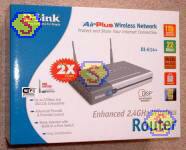
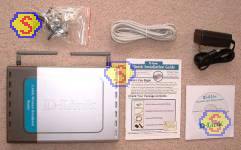
Here is the wireless PCI adapter I'm using, the D-Link DWL-520+, which I also purchased at Amazon (again, clicking the link takes you directly to it). Click on either picture to see it enlarged.
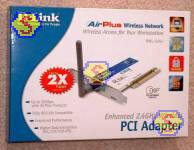
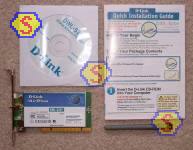
The antennas that come with the D-Link products are actually quite good, even if they look spartan in design. However, the signal quality reported at the computer containing the wireless PCI adapter can be severely degraded by intervening objects. It's natural and expected for there to be walls and floors between the router and wireless PCI adapter, but if there are several walls or if the angle through the wall that the signal must travel is very narrow then the signal quality may degrade to unacceptable levels. The signal quality is also degraded by traveling through equipment, like refrigerators or the computer itself. It my case, I improved my signal quality from 52% to 72% by using a Belkin Wireless Desktop Antenna which I purchased at Amazon.com (clicking the link takes you directly to it). This is all the difference in the world. A signal quality of 52% is about the same as "no connection". A signal quality of 72% seems to work perfectly. The nice thing about this antenna is that it has a 5-foot cord, which is very long by external antenna standards. It's nice because it gives you some range in where you place the antenna. Other antennas I've seen are barely 2-feet in length, which is only long enough to get the antenna to the top of the computer case. Click on the picture to see it enlarged.
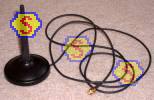
After installation is complete, a good test is to download a large file, say 10MB or more, and see how fast it transfers on each computer. The computer using the wired connection to the router will be faster. In my case, this computer transferred the file at 150 - 160 kB/s (kilobytes per second). The computer connected to the router via the wireless connection transferred the same file at 50 - 56 kB/s, or at about one-third the rate. Now your actual mileage may vary and, in fact, mine does too based, I assume, on how busy the rest of internet is within and beyond my neighborhood at different times. However a wireless transfer rate of about one-third the wired rate is about right. In addition, enabling 256-bit WEP seemed to reduce the wireless transfer rate during my test to 45 - 48 kB/s. So that's the unscientific analysis. In plain language: without 256-bit WEP enabled the wireless connection seems blazing fast and there's very little if any discernable difference in surfing the web on the wireless computer versus the wired computer, but with 256-bit WEP enabled there is a noticeable drag on performance. Using a less secure encryption, such as 64-bit WEP, is less of an impact to performance.
The latest firmware and drivers for these products can be downloaded from D-Link Technical Support.
This What do I need for wireless networking FAQ from Anandtech.com provides a very clear, quick-to-the-point summary on the subject of wireless networking.
Or check out PracticallyNetworked.com for a very comprehensive reference on the subject.